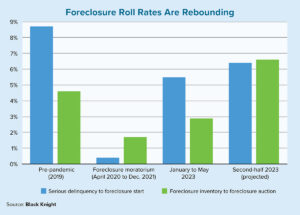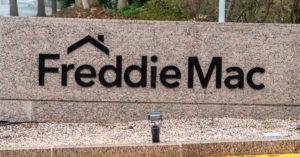Picture a scenario where a real estate investor and a loan officer are seated at a table facing each other. The loan officer asks a common but important question: “What’s your exit strategy for this investment?” The prospective borrower replies, “Well, given the market conditions, I’m not sure yet.”
Lenders across the country have heard this exact response for the better part of the past year. Investors always have a preferred method for doing business, whether it’s commercial real estate or a different venture. In the same way that stock investors may prefer high-risk portfolios with a chance of high-yield dividends, real estate investors may prefer gut renovation or fix-and-flip projects that turn the worst house on the block into the best one, with the opportunity to sell and earn a large one-time profit.
“When real estate markets change and investment strategies become uncertain, the rigid lending options that involve placing deals into specific buckets start to become less useful.”
But in today’s volatile market that’s tied to such factors as Federal Reserve rate hikes and cooling home prices, investors with what would normally be a straightforward business plan are on the ropes and questioning their exit strategies. Experienced borrowers who buy, rehab, rent, refinance and repeat are timid about acquiring their next investment property due to inflated interest rates. They want to avoid entering into a long-term financing agreement at the wrong time.
There are developers that started a ground-up construction project nearly a year ago. But now, as the project is complete and ready to sell, the developer is looking at market prices that have dipped far below their initial target. They’re hesitant to release their asset for a subpar profit.
These issues are causing uncertainty, but they’re not the real problem. For commercial mortgage brokers and their clients, the real issue is that the type of flexible lending that can remedy this situation doesn’t seem to exist on a large scale.
Square peg, round hole
Nonconventional lenders have always had a market advantage in terms of flexibility, but there’s also a trend of them being slow to adapt. Instead of using their flexible nature to be proactive, many lenders are playing catch-up at the cost of potential long-term business.
When real estate markets change and investment strategies become uncertain, the rigid lending options that involve placing deals into specific buckets start to become less useful. Essentially, these lenders spend each day placing square blocks into square spaces. One day, the space becomes a circle, but the lender keeps trying to insert the same square block.
Recently, private money lenders have been seeing an uptick in borrowers and brokers who seek financing that allows for both a flexible project timeline and a flexible exit strategy. These investors are unsure whether they want to hold an asset for years or sell quickly, nor are they certain of their timing. It’s a tough request for a lender — what type of financing option do you offer an uncertain borrower? As these requests continue to pour in, lenders have been forced to brainstorm solutions that can put borrowers at ease while they figure out the ultimate plan for their investment.
New product offerings have been developed in response to these broker and borrower requests. Take, for example, a two-year bridge loan program for stabilized properties. This interest-only financing option can act as a true bridge loan.
In these situations, the renovation or construction aspects of the project have been completed. The investor has decided that their local market conditions don’t favor an immediate sale, but they also wish to avoid locking themselves into a long-term rental loan with exorbitant prepayment penalties. A two-year bridge loan can offer them quick and affordable capital, a flexible timeline and the ability to pivot based on evolving market conditions.
Win-win situation
How does this option work? By ensuring there are no prepayment penalties, borrowers are given security for up to 24 months. They have the ability to sell the property at any time or refinance into a permanent mortgage, such as a 30-year debt-service-coverage ratio (DSCR) loan.
Essentially, they are buying themselves stability and time while collecting passive income by renting out their investment property. The lender benefits too as these stabilized properties minimize risks and keep bridge loans away from bailouts of any kind. It’s a win-win for all parties.
In an ideal world, this type of product will eventually become obsolete. Market conditions will stabilize, allowing investors to become more steadfast in their business and exit strategies. Mortgage brokers who know what their clients’ needs are can give them direction with confidence.
To that effect, lenders might question the decision to roll out a program that’s meant to have a temporary shelf life. The question is, what is the cost of being a flexible lender? This might only entail a handful of meetings to sort out details and answer questions from originators, along with a few hours to build marketing content. In other words, the time and effort spent is likely to be minimal compared to the value gained in securing clients who have expressed uncertainty about their current and future deals.
Private money lenders should constantly strive to make their loan programs as flexible as possible. They should do so with the same sense of urgency that they apply to closing loans. But this doesn’t mean jumping the gun every time the market takes a turn.
If you develop a product too soon, you risk wasting time and resources trying to solve a market problem that winds up resolving itself. Act too late and you’ve missed the opportunity to become a reliable lending partner during unpredictable times. These are trial-and-error situations, but the more often you lean into the creation of flexible lending programs, the easier it’ll be for you to determine whether a pivot is needed or staying the course is the best strategy.
● ● ●
As real estate markets slowly stabilize, traditional lending programs will regain their usual traction. But specialized programs, such as bridge loans for stabilized properties, provide opportunities. There is relief in a broker’s voice when they realize they’ve found a solution for their client in turbulent times.
Real estate investors need loan products that match present-day market conditions. The lenders that don’t lean into volatile markets will miss out on growing their book of business, while those that do will be remembered fondly when it comes to future dealmaking activities. ●
Author
-

Eric Krattenstein is a partner, chief marketing officer and head of sales for Asset Based Lending (ABL), a private commercial mortgage lender that has funded more than 3,000 loans with a combined value of more than $1.1 billion for residential and mixed-use commercial properties. ABL is operated by knowledgeable and experienced real estate lenders who want to help investors succeed. Its mission is to help investors quickly and efficiently finance their business activities. Learn more at www.abl1.net.




